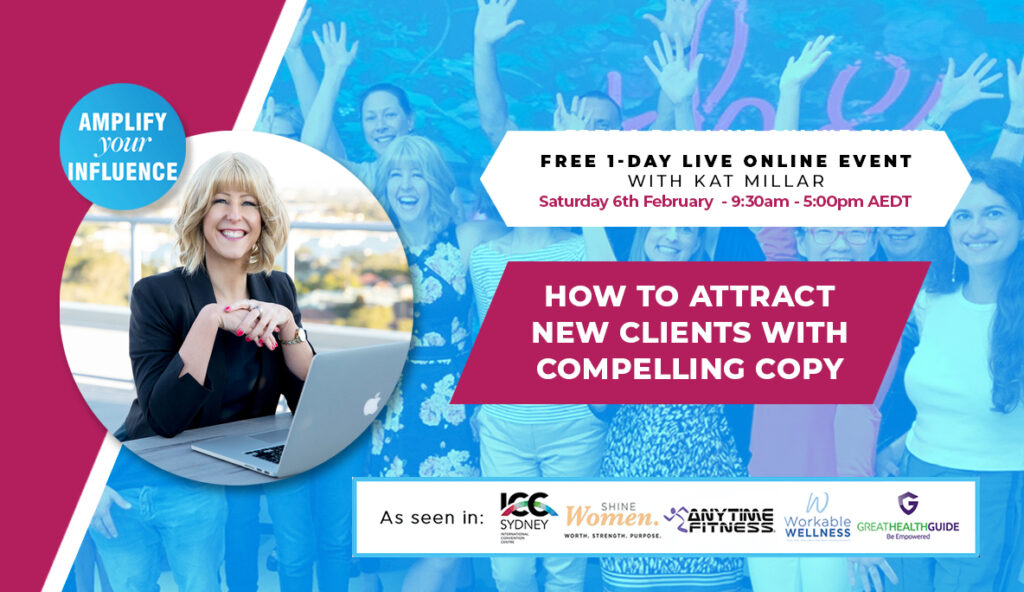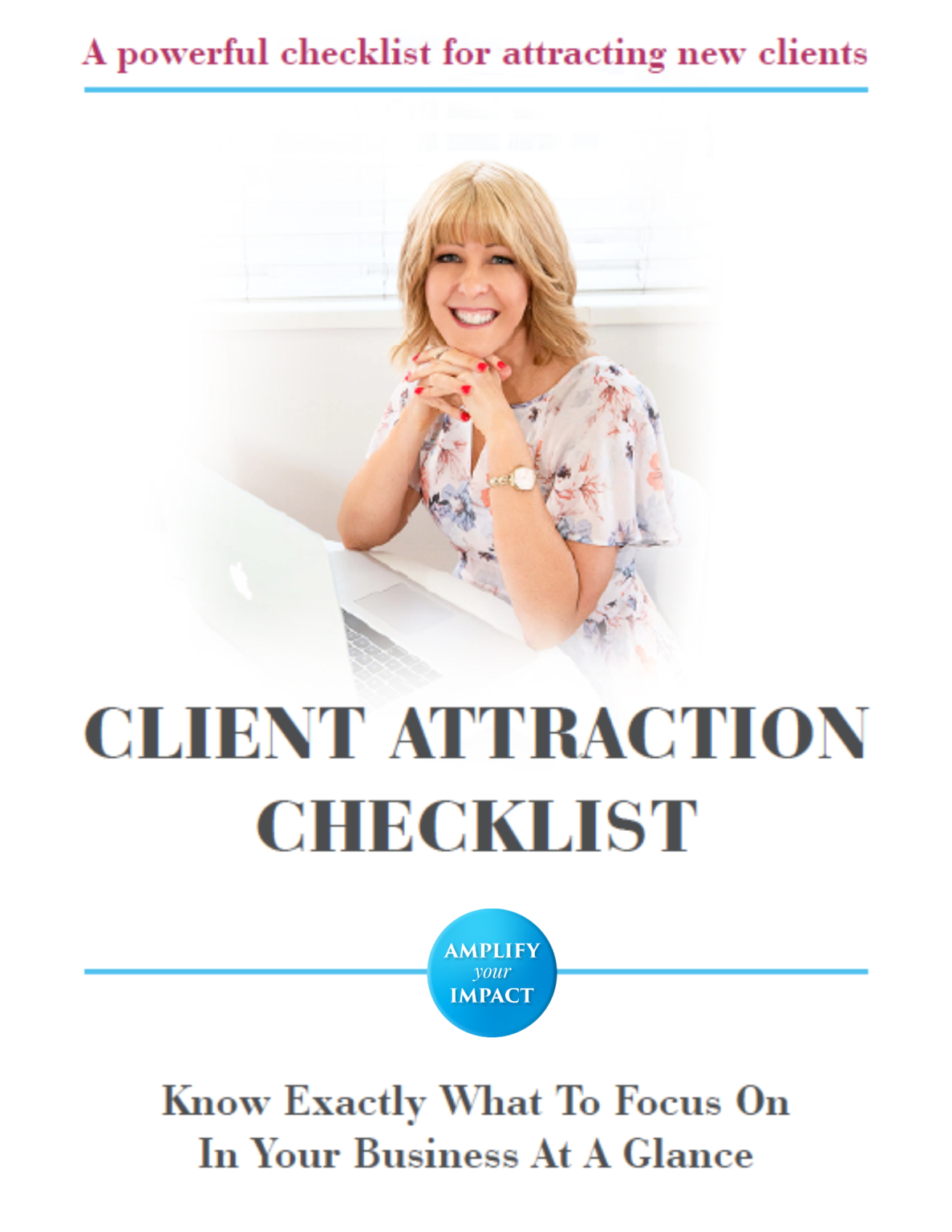Are you clear on what makes you different?
Having a USP (unique selling proposition) helps you stand out online and differentiates you from your competitors.
People searching for a solution online are often overwhelmed with options. They want to quickly be able to identify why you’re different to your competitors, so they know why they should choose you, as opposed to another business.
Your USP is what makes your business stand out. At its core, it should quickly answer that question that your potential clients have in their mind, which is “What makes them different from other options I’m looking at?”
Understanding your USP is crucial to guide your marketing decisions.
I like to think of your USP being the sweet spot between what your client wants and what you are really good at.
 A really compelling USP should be memorable. And it should be specific and tangible. It shouldn’t be, “We deliver fast service” or “We have a high-quality service.” That’s very vague and general.
A really compelling USP should be memorable. And it should be specific and tangible. It shouldn’t be, “We deliver fast service” or “We have a high-quality service.” That’s very vague and general.
You want it to be specific, so it’s your offer, your way of teaching, your methodology, framework, or formula that makes you different.
It should also be focused on what your ideal clients value because there’s no point in being unique just for uniqueness’s sake.
It needs to be something important to them so they truly care about it. And it’s more than just a slogan and a compelling tagline. It’s something that you incorporate into every area of your business. You show your uniqueness and craft your message around that.
So here are 5 fun ways to create a powerful USP and stand out online…
1 – Unpack Your Uniqueness
To unpack your uniqueness, think about the things that you do that other people struggle to do, but you do it really naturally and really easily.
At the moment I’m working with a client and we are working on crafting their webinar and building a framework around it. She couldn’t believe how easily I could come up with a framework, because it comes effortlessly for me.
 What are the things that you can do easily, that come effortlessly to you because you’ve done it for so long? This is part of your unique brilliance and your genius zone.
What are the things that you can do easily, that come effortlessly to you because you’ve done it for so long? This is part of your unique brilliance and your genius zone.
People pay really good money for people who work in their genius zone. People are born with talent and gifting’s, but your USP also includes your mastery of an area, your skill acquisition, time and effort you’ve put in to learning.
There’s a difference between being gifted and talented, and actually being masterful at a skill because you’ve honed it and unpacked it. You’re not just brilliant at it, you’ve unpacked that gift and you’ve developed it.
What kind of things have you really developed that other people haven’t developed? Also think about what your friends, family, clients and people that you know would say you’re really great at?
Unpacking your uniqueness is finding what makes you who you are. Then think about your personality. Not everyone wants to work with certain personality types. Just your personality can be enough to differentiate you from other people.
Your USP doesn’t have to be some really crazy thing that no one else is doing. For me, I’m a combination of practical business skills and strategy, and also mindset and spiritual. So these are things I’ve combined in my business that made me a little bit different.
I only ever teach what I do. Some people are just learning, teaching, then learning and teaching, but they are not actually applying it and getting success before they teach other people.
I think about my background as a teacher and a trainer for 6 years. I was a teacher, trainer and assessor. I was a lecturer in business and fitness, so my training background is part of my USP.
I have an ability to run full-day workshop online and this makes me a little bit different to some people that don’t have that background. So think about what work you’ve done in the past and think about different combinations of things that you’ve done that are different.
The very first person who taught me presenting had a copywriting background. He used to be a copywriter and he pulled that skill set into his presenting skills and it was a really unique combination. It was actually why I signed up for his program.
 So think about the work you’ve done in the past 10 or so years. My background is as a weight loss coach and personal trainer, so now a lot of my clients are in wellness and it’s part of my USP.
So think about the work you’ve done in the past 10 or so years. My background is as a weight loss coach and personal trainer, so now a lot of my clients are in wellness and it’s part of my USP.
I understand the process of transformation. I can really help a lot of people who work in the health, fitness and wellness industry, because I’ve worked in it myself.
I have a client who runs a gym in Melbourne, and I’m helping them work through their whole sales process, because I’ve worked in a gym for so long. My skills used as a trainer in a gym apply to business.
I have an understanding of mindset and breaking through limiting beliefs, which come up in business all the time. I used to train world champion bodybuilders, so I understand resilience and the entrepreneurial mindset of having to push through when things are hard.
Think about your gifts, skills, your area of brilliance, your personality, and other unique traits you hold. These are what make you a little bit different. These are part of what makes you unique and they form your USP.
2 – Dig For The Difference
Digging for your difference is really about defining how your program is different. Your USP defines your uniqueness, and then you have to dig for the difference, which is why people will be attracted to your program or offer.
What is it in your program, or in your offer, or your service that could be a little bit different? Maybe you include some finished components, so you’ve done work for them already.
I do that usually as a bonus, where I might do a “done for you landing page” for my clients or some “done for you copywriting”. I also offer lifetime access to my modules for my online courses, and that’s something that not everybody offers.
When you think through the components of your offer or your program, what are some things that other people don’t offer? Maybe you’re really good at making things very clear and step-by-step. Or perhaps you’re very good at organising your knowledge and taking someone through step-by-step.
Maybe your program has one-on-one components, because you’re still a small business and small enough for it to be really personalised. This is something that makes me a little bit different. I’ve learned from multi-million dollar companies and I’ve invested lots of money in them. I’ve learned a lot of strategy from them.
But my business is still at a point where I can be personalised, so people don’t just become a number and get lost in the crowd. I can have a really small, specific mastermind of a few people so that there’s lots of personalised support from me.
Another reason why my program is different, is that a lot of programs give monthly group coaching calls. And I decided to make my group coaching weekly, because I just really wanted to provide that level of ongoing support.
 So you might think about what your program looks like in terms of the level of support you give. You may want to do daily texts for people.
So you might think about what your program looks like in terms of the level of support you give. You may want to do daily texts for people.
When I was working as a weight loss coach, one of the motivational things I came up with, was that I would text my clients a motivational text every morning.
The very first course I did was in MailChimp, my online CRM. Every Monday, Wednesday and Friday, my clients would get an email. I had Monday Motivation, Winning Wednesday and Friday Feast. I would email my clients a YouTube link, or a recipe, a motivational quote, or image.
This was a 12-week program so I created 36 emails for it. People just loved receiving these motivational, inspirational things in their inbox. So think about what you can do to make yourself a little bit different.
Something I do in my program, is I have a manifesto. When I used to do live events, I would laminate a manifesto and put a little chocolate and a few different things in a gift pack on the chairs, so when people came into the boardroom, there was something a little extra there.
When I was running a business speaking group, I created a card and superimposed the person’s face over a TED talk speaker. I did it on Canva. I put their face on that person’s body, and it was like them delivering a TED talk and I put a caption, “This is going to be you one day.”
These cute, fun, and quirky things are part of the culture you are building for your community. I run an inner circle community which is a small, private Facebook community and I’m in there answering questions every single day.
I know that’s different because a lot of programs don’t have the course creator actually answering the questions every day. They get admin people to do it. And I may not always do this, as my business grows, but right now I can do this, so this is another point of difference I offer.
3 – Pinpoint Your Promise
Pinpointing a promise is like you’re making a pledge to your clients. This can be implied, not just spelled out in your USP statement. You want to think about the result of what you are going to promise your client.
 Give an outcome in your promise. An example is, “If you follow these steps, you will get this outcome.” Or it could be, “If you follow this formula, you will get this result.”
Give an outcome in your promise. An example is, “If you follow these steps, you will get this outcome.” Or it could be, “If you follow this formula, you will get this result.”
I did a challenge a few years ago and it was a $10K challenge that the guy promised. It was such a clear promise. He promised if I did his steps, I would make $10k.
It takes courage and boldness to have a strong promise like that, but it’s absolutely worth thinking about. If your promise has any type of number or dates within it, like, “Lose 5 kilos in five weeks.” People absolutely love these.
A friend of mine has a promise of, “Book 3 discovery calls in 48 hours.” This has got the number and the dates, so it’s super powerful.
4 – Comb Your Competitors
Combing your competitors means looking at what your competitors do who are above you, and then implementing that. Look at 3 different businesses who are above you at the next level and model them.
Don’t copy. Look at the language they use because they’ve obviously done a lot of research. If they’re quite ahead of you, they’ve really done a lot of research, so look at what they’ve done differently.
Then look at what you can do to bring something different or better. Ideally, do something better. If you’re just starting out now, look at how you can beat them. Use the fact that you’re smaller because you can use being small to your advantage.
Being a smaller business means you can provide personalised support and service that a lot of big companies can’t do because they’ve grown so much. They can’t do one-on-one anymore because they’re just too busy. Use what you’ve got and play to your strengths.
I’ve got a new client in Utah and she’s fabulous. She’s got 3 different target markets. She’s a real estate agent, and we were talking about how she will find the language that each 3 target audiences use.
My suggestion was to choose 3-5 Facebook groups to hang out in every single day for 7 days. Spend a good 10-20 minutes there each day, reading people’s comments and questions, and she will get a good feel for what people want and how to use their language.
5 – Start A Story Bank
Your stories are really what makes you unique. Your unique stories are valuable and they are yours, so start a story bank.
Open a Google document or spreadsheet, and think about your ideal clients. Think about their 3 biggest pain points and problems. Then think about a time in your life where you had these problems.
I decided to group it in decades. So from 0-10 years old. 10 to 20 years old etc. I know this sounds crazy and you probably are thinking why things from childhood can be relevant, but you can take learnings and wisdom from these experiences.
Say for example, when you were 9, your mum left or you moved overseas. Share the wisdom you have drawn from that experience. It doesn’t have to be directly related to your business. Then think of 3 instances from each decade from your life that relate to the pain points your target market experience.
 Your combination of stories and experiences really makes up your USP. If you’re 45-years old, you’ve got 5 decades to draw from. That’s 15 stories you could have.
Your combination of stories and experiences really makes up your USP. If you’re 45-years old, you’ve got 5 decades to draw from. That’s 15 stories you could have.
They could be turning points or an emotional experience where you had some kind of pain or problem that potentially is going to relate to your ideal client.
One of the things that led me to push to build a business is, I remember seeing my Dad be so diligent and going to work every single day at the same company for 40 years. But he left that job with no intellectual property.
I don’t want that to happen to me. I want to have a legacy that I build. I want to create something that’s mine. I don’t want to pour my heart into someone else’s business or company.
When I was a teacher for 6 years, I was teaching someone else’s curriculum and that really bothered me, because I wanted to be teaching my own content. These types of stories are going to help your unique selling proposition.
I have a client in Ukraine. I met him when I was living in London and he connected with me 10 years later. He is adopting a new daughter. He said he needed a coach and he wanted to work with me. He has a beautiful team of people who are growing his company with him.
We’ve just gone through this process of defining his USP. It started off as a community dedicated to impacting orphans, so it was all about orphan care. His heart is to help orphans because that’s where the sex trafficking trade thrives, when orphans are released and don’t have family support.
Then we were looking at another community that was wider and broader called, Journey For More. They are ordinary people doing extraordinary things. We were toying with the idea of going more specific or whether he should go broad to make his community broader.
We decided on something in the middle, “Live Your Fullest Calling By Contributing To The World’s Most Pressing Needs.” We found this in-between space, where it’s all about everyday people wanting to contribute to a cause that is one of the world’s most pressing needs.
It’s a beautiful example of how we need to craft and think about where we’re at in our journey, what types of clients we want to attract, and how we want to be specific and clear, but also open it up so that you can really grow and expand as well.
So that’s 5 fun ways you can create your USP and stand out online.
I recommend you share your USP on social media, in emails, and in other places you show up online, such as if you are interviewed on a podcast or Facebook Live video.
You don’t just want to create your USP and put it in a drawer or in a folder. You want to consistently be showing your uniqueness.
Take the time to think about your uniqueness and why someone would listen to you over someone else. And then keep repeating that same message.
You might feel like a broken record. I do sometimes, but repetition is the mother of skill and it’s one of the key ways that people get to know your brand, messaging, and what makes you unique.
Want help defining your USP and uniqueness to stand out?
I offer a free discovery session for first-time people who want to take their business to the next level, so if you need help, please don’t struggle alone. Reach out.
Apply for a free strategy session here
Chat soon,
Kat
 Success is not about just people liking and commenting on your posts. The most successful people actually aren’t spending all this time on social media checking likes and checking comments.
Success is not about just people liking and commenting on your posts. The most successful people actually aren’t spending all this time on social media checking likes and checking comments. Crafting influential content works. You don’t have to have 1000’s of people on your mailing list, you just need to know how to influence people.
Crafting influential content works. You don’t have to have 1000’s of people on your mailing list, you just need to know how to influence people. If we’re not being our natural selves, our content can sound formal, when we wouldn’t speak that way with our friends or family if we were chatting over a coffee.
If we’re not being our natural selves, our content can sound formal, when we wouldn’t speak that way with our friends or family if we were chatting over a coffee. When I decided to do a bungee jump, I wanted to feel the thrill and the freedom of throwing myself off a bridge. I wanted to feel brave and courageous.
When I decided to do a bungee jump, I wanted to feel the thrill and the freedom of throwing myself off a bridge. I wanted to feel brave and courageous.
 Marketing is about targeting the right people and being willing to not attract everyone. Leaders and influencers are not afraid to repel some people, when the right people are drawn to them.
Marketing is about targeting the right people and being willing to not attract everyone. Leaders and influencers are not afraid to repel some people, when the right people are drawn to them. If you want to have compelling copywriting, you want to have a good balance of strength and warmth. Take the time to assess yourself and ask yourself where you sit on the strength and warmth spectrum. Even ask some people close to you for how they experience you to be.
If you want to have compelling copywriting, you want to have a good balance of strength and warmth. Take the time to assess yourself and ask yourself where you sit on the strength and warmth spectrum. Even ask some people close to you for how they experience you to be. It’s inspiring people to act. That is what valuable content is. Valuable content is not ‘3 tips’ or ‘3 secrets’ or ‘3 methods’.
It’s inspiring people to act. That is what valuable content is. Valuable content is not ‘3 tips’ or ‘3 secrets’ or ‘3 methods’. We can’t ignore this truth.
We can’t ignore this truth. These 7 things are triggers that people will take action to avoid.
These 7 things are triggers that people will take action to avoid. A really compelling post can make you a lot of money.
A really compelling post can make you a lot of money.
 When you name things and make them a formula, a roadmap, a blueprint, a method or pillars, you’re organising your knowledge and you’re putting a framework around it.
When you name things and make them a formula, a roadmap, a blueprint, a method or pillars, you’re organising your knowledge and you’re putting a framework around it.
 There are people who are the right fit for you. And there are people that are definitely not the right fit for you.
There are people who are the right fit for you. And there are people that are definitely not the right fit for you. When you’re learning an instrument, there’s certain notes that work well together, like C,E and G, that make a nice sounding chord.
When you’re learning an instrument, there’s certain notes that work well together, like C,E and G, that make a nice sounding chord. Big, fancy words is the old way of writing. The new way is conversational.
Big, fancy words is the old way of writing. The new way is conversational. The only way really to find your voice is to write a lot. It doesn’t come by thinking about it. It doesn’t come by reading about it.
The only way really to find your voice is to write a lot. It doesn’t come by thinking about it. It doesn’t come by reading about it. An example I encountered once was where a guy asked me to help him to change his marketing, because he wasn’t getting anyone signing up for his event.
An example I encountered once was where a guy asked me to help him to change his marketing, because he wasn’t getting anyone signing up for his event. Your copy needs to create a scene where your ideal client can see themselves.
Your copy needs to create a scene where your ideal client can see themselves. You could buy a really cheap bottle of wine and you’d get five or six big glasses out of this cheap bottle of wine.
You could buy a really cheap bottle of wine and you’d get five or six big glasses out of this cheap bottle of wine.
